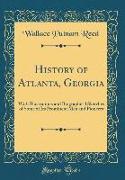History of Atlanta, Georgia: With Illustrations and Biographical Sketches of Some of Its Prominent Men and Pioneers (Classic Reprint)
BücherAngebote / Angebote:
Excerpt from History of Atlanta, Georgia: With Illustrations and Biographical Sketches of Some of Its Prominent Men and PioneersIt is deemed proper in this connection to brie¿y review the rebuilding of the city after its destruction by order' of General Sherman. This was in Sep tember, 1864. In November and December of that year, the people began to return, but many of them having made more or less permanent arrangements for winter residence, did not return until the next spring. Before the end of 1865, most of the old citizens had returned, and besides them many others Who had been ruined by the war determined to seek their fortunes in what had been for many years looked forward to as the metropolis of Georgia. In 1866 the population of the city exceeded the highest figures it had attained before the war, reaching and in 1870 Atlanta had become the second city in the State, being surpassed only by Savannah. The rebuilding at first was carried on without much attempt at style or system. Hundreds of brick and wooden buildings were erected out of the de'brz's of the ruins, that being the only mate rial at hand, and the putting of it to that use being the most economic way of clearing the ground. Er Lawshe erected the first store on Whitehall street by the removal ofa small one-story building from another part of the city. Sim ilar work was done by many others. Building materials were scarce and high, . And in consequence the rents of such buildings as were put up were equally high. This state of things continued for several years, and had a stimulating effect on building operations. By 1869 and 1870 matters had settled down to a more normal and healthy condition. Many of the small buildings and shan ties had been erected from the necessities of the case immediately after the war, began to be replaced by larger stores, and many splendid residences be gan to rise in different parts of the city. During the four years from 1869 to. 1872, building was carried on on an extensive scale. Some of the larger buildings with the year in which they were erected are as follows: John H. James built his banking house in 1865, and in the same year mcnaught Scrutchins built their store on \vhitehall street, and C. Peck his planing mill. 0. H. Jones also built fine livery stables for the accommodation of his increasing trade in stock. The Third Baptist Church was built in 1868, E. E.' Rawson's store on Whitehall street in 1869, Moore Marsh's store on Deca tur street, John H. James's famous residence on Peachtree street, now the gov cruor's mansion, was also erected that year at a cost of In 1870. Louis degive built the. Opera House, the corner stone of the Church of the Immaculate Conception 'was laid. The Fourth Baptist Church was built by John H. James, H. I. Kimball built the Kimball House, at a cost of about and B. F. \vn built a handsome residence on Washington street. In 1871 there were erected at least four hundred buildings, among them the Republic Block on Pryor street, the Austell Building on Decatur street, and the Union Passenger depot. In 1872 the Fifth Baptist Church was erected by John H. James, a three-story building was erected on Broad street by ex-governor Brown, a large agricultural warehouse by Mark \v. Johnson, and a hardware building by Thomas M. Clarke, besides numerous residences.454 history OF atlanta.About the PublisherForgotten Books publishes hundreds of thousands of rare and classic books. Find more at www.forgottenbooks.com
Folgt in ca. 15 Arbeitstagen
